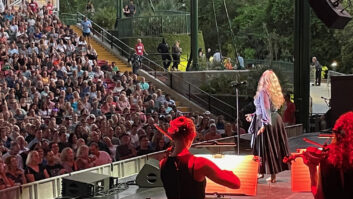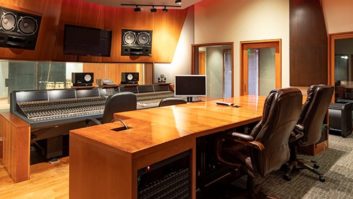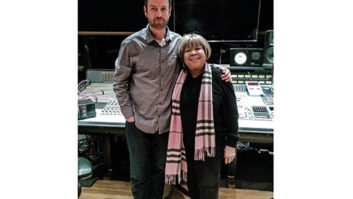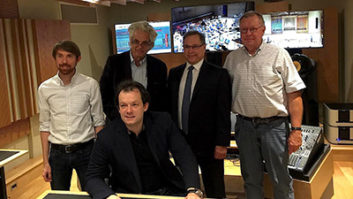Yamaha is a leading pioneer in low-cost/pro digital mixers, having introduced the industry-standard 02R seven years ago. Now, with the launch of the DM2000 Digital Production Console ($18,300 base price), the digital-savvy manufacturer enters the sparsely populated, mid-priced digital console market.
Make no mistake, the DM2000 is not just a larger version of preceding production models. The 24-bit/96kHz, 96-input, 30-output, 8-bus surround console is jam-packed with upscale features such as a 22×8 matrix, digital channel-assignment strip, onboard sample-rate converters, multichannel surround effects, remote transport control of multitrack recorders, and remote fader/encoder layers to control popular DAWs (including Pro Tools and Nuendo). And, unlike many boards that tout 96kHz operation, the DM2000 won’t “steal” channels when working at high sample rates; all 96 inputs and 30 outputs are available at all sample rates, including 96 kHz. Equally important, the DM2000 puts the concept of “control” back into the control surface, with nearly 500 buttons, switches, rotary encoders and faders that provide fast and exact command over online and offline functions.
HARDWARE I/O CONNECTIONS
The DM2000 measures 10.1×32.3×35.7 inches (H×D×W) and weighs 94.8 pounds (without the decorative optional SP2000 wooden side panels, which list for $600). Aside from a single headphone output situated in the far-right corner of the control surface, all I/Os are located on the console’s rear panel. The DM2000 provides 24 A/B analog inputs via 24-bit, 128x oversampled A/D converters, which operate at 44.1/48/88.2/96kHz sampling frequencies. All of the console’s ADCs and DACs — including the talkback A/D — are 24-bit/96kHz, 128x oversampled. The “A” inputs are balanced female XLRs; “B” inputs are balanced ¼-inch TRS jacks, which also accept unbalanced inputs.
The A and B inputs have a nominal input range of -60 to +10 dBu, good for handling any signal from a weak mic to hot line levels. (Only the XLRs receive phantom power.) Unfortunately, A/B switches are not provided; plugging a connector into a B-input TRS jack kills the signal to the corresponding XLR, making simultaneous patchbay connections for all inputs not feasible. Separate insert in and out jacks (balanced TRS, +4dB nominal level) serve each A/B input pre-ADC.
Six card slots accept various optional mini YGDAI cards offering multichannel digital or analog I/O, yielding as many as 96 channels of bidirectional I/O using the new MY16-AT cards. See the table for more info.
Additionally, eight “omni” analog outputs (+4dB nominal level) on balanced TRS jacks can be fed from the console’s bus outs, aux master sends, matrix master sends, master stereo out, direct outs, surround monitor channels or digital-insert outs. The console’s 96 input channels, eight buses, 12 aux sends, four matrix sends and master L/R bus all have digital inserts! Because the DM2000 doesn’t offer any dedicated effects-send outputs, engineers who mix with a lot of analog outboard processors (especially in conjunction with analog surround monitor feeds) will probably want to supplement the stock omni outputs with at least one or two analog-output cards.
The DM2000’s S/PDIF and two AES/EBU digital outs can each serve as outputs for the stereo master out, bus outs, aux sends, matrix master sends, direct outs, insert outs or control room outs (which is useful to hook up digital monitors or reference D/As). Using the DM2000’s internal sampling-rate converters, you can set the sampling rate of these outputs to be different from the rate at which the rest of the console is operating.
The console’s S/PDIF and two AES/EBU digital inputs can provide access to internal sample-rate converters. In addition to simply monitoring digital 2-track returns via these inputs, you can route the returns to any input channel, input-channel insert in or output-channel insert in. The DM2000’s two pairs of analog 2-track returns can also be routed to these destinations. (More on analog 2-track returns in a moment.)
One wordclock input and two wordclock outs are provided on BNC jacks. Word Clock Out 1 outputs the same clock rate as the console, while Word Clock Out 2 delivers half of the clock rate (44.1 or 48 kHz) when the DM2000 is operating at a high-resolution (88.2 or 96kHz) rate. This is useful with recorders that require 48kHz wordclock (which they double internally) to record 96kHz audio. Happily, the DM2000 supports double-channel digital I/O for high sample-rate recording on legacy 44.1/48kHz multitrack recorders.
The outputs for two pairs of control room monitors and the L/R master bus are balanced XLRs. Stereo studio monitor outputs (for musicians’ cue feeds) and analog 2-track returns are balanced TRS jacks. Two-track analog I/Os are also provided on unbalanced -10dBV phono jacks.
MIDI In/Out/Thru ports support chores such as recalling scenes (automation snapshots), controlling real-time console parameters, Bulk Dumping automation and other data, controlling external machines (including transport functions and track arming) via MMC, and controlling DAWs via the DM2000’s predefined remote layers. USB and serial ports handle multiport (supplying eight ports) communication between the DM2000 and a host Mac or PC. Alternatively, installing an optional mLAN I/O card in slot 1 supports 8-port communication over Yamaha’s proprietary network. MTC and SMPTE inputs (the latter on a balanced XLR connector) allow synchronizing automixes (dynamic automation moves).
A 15-pin D-sub connects to the optional MB2000 Peak Meter Bridge ($1,100). The MB2000 shows levels for all of the console’s I/O and four remote layers, and allows users to globally set pre-EQ, pre-fader or post-fader meter source points for inputs and outputs. A large timecode readout and connections for two lamps (with a dimmer) add the finishing touches to this outstanding meter bridge. Users who decline to purchase the MB2000 can access meters (and a wealth of other data) on the backlit, 320×240-dot LCD screen near the center of the DM2000’s control surface.
Besides the dead-quiet cooling fan, the rear panel also features a port to connect a PS/2-compatible keyboard (for quick titling of scenes, automixes, libraries and so on), a GPI Control port (used to control external gear with the DM2000’s faders or 16 user-defined keys) and a 9-pin D-sub remote port (for remote control of machines that support the Sony P2 protocol, such as the head amps on the optional Yamaha AD824 A/D converter). Anyone who needs lots of inputs should note that up to four DM2000s can be linked using the console’s Cascade In/Out ports.
A/D INPUT AND CHANNEL STRIP CONTROLS
On the DM2000 control surface, each of the 24 A/B input channels features a -26dB pad, detented (+44dB range) gain pot, analog insert on/off switch, and separate signal presence (-20 dB below nominal) and peak (3 dB below clipping) LEDs. There are 24 48VDC phantom power switches for each of the “A” (XLR) inputs.
The DM2000’s 24 100mm channel faders (as well as the stereo master fader) are touch-sensitive and motorized. The channel faders set I/O levels or remote-control parameters in nine different console layers and can be used to punch in automix moves on a channel-by-channel basis. The faders are joined by On, Solo, Channel Select and Auto buttons in each of the console’s 24 channel strips. The Auto buttons can be used to set automix playback and recording status — including on-the-fly punch ins/outs — independently for each channel.
The rotary encoder in each channel strip can be used to control channel-input panning and matrix-send balance (Pan Encoder mode), or aux and matrix-send levels (Aux/Mtrx Encoder mode). In each of the four additional assignable encoder modes, one of the 44 available parameters can be mapped to the encoders. For example, the encoders could adjust surround LFE levels in Assignable Encoder mode 1, and the head amp gain on Yamaha’s AD824 external A/D converter in Assignable Encoder mode 2. Awesome!
As mentioned earlier, faders and other controls in the DM2000’s 24 channel strips can access nine different console layers: four input-channel layers (serving input channels 1 through 24, 25 through 48, 49 through 72, and 73 through 96, respectively); one master/output layer (controlling the eight buses, 12 aux sends and four stereo matrix-send masters); and four remote layers (using the channel strip’s faders, encoders and on buttons to control external MIDI gear and DAWs). The DM2000 includes preprogrammed, remote-layer setup templates for Nuendo and Pro Tools; additionally, users can store custom controller-to-MIDI parameter setups within scenes for their own particular DAWs.
The DM2000 offers eight fader groups and eight mute groups, and input channels can be paired (both horizontally and vertically) across layers. Bus outs, aux sends and surround pans can also be paired horizontally.
Above the DM2000’s faders is a gorgeous fluorescent assignment strip that graphically displays each channel’s bus routing, encoder value and on/off status of the channel’s EQ/insert/delay/compressor/gate functions. It also displays custom user names (e.g., “kick,” “vox”) for each channel; unfortunately, these names are not stored in scenes. [This is possible in the latest Version 1.1 software. — Ed.]
I/O ROUTING
The DM2000’s routing capabilities are nothing short of astounding. Input channels, bus outs, aux sends, matrix sends and the master stereo out all feature digital inserts that can be independently placed pre-EQ (post-gate), pre-fader (post-EQ) or post-fader. Any available input port (e.g., from a card slot, A/D, etc.) can be routed to any of the console’s digital insert ins, as well as to any of the 96 input channels or eight internal effects inputs. Insert outs, direct outs, bus outs, aux sends, matrix sends and the master stereo out can be routed to any card slot, omni or digital 2-track output port. Inserts can also be patched to internal effects. Users can also store their most used I/O-routing setups in 64 libraries that are dedicated to this purpose.
Adding to the console’s flexibility, the master stereo output and all input channels, bus outs, aux sends and matrix sends have independent compressors. The DM2000 also offers six (total) 31-band graphic EQs that can be inserted into the bus outs, aux sends, or the left or right channels of the matrix sends or master stereo output.
SELECTED CHANNEL CONTROLS
All 96 input channels feature a gate, 4-band parametric EQ, delay and — as noted before — a compressor. All 30 output channels (buses, aux sends, stereo matrix sends and master stereo output) offer a 4-band parametric EQ, delay and compressor, as well as provide access to the aforementioned pool of six graphic EQs. Separate libraries are provided to store/recall your custom graphic equalizer, 4-band parametric EQ, gate, compressor, effects and channel settings.
Five rotary controls handle dynamics processing. A button toggles the rotary-control assignments between gate and compressor functions so that they serve either as dedicated threshold, range, attack, decay and hold controls for the gate, or as dedicated threshold, ratio, attack, release and gain controls for the compressor. Separate gate and compressor on/off buttons are also provided.
The parametric EQ section provides two control knobs (one for gain, the other toggles between frequency and Q) for each of the four bands. This arrangement lets users simultaneously adjust two EQ parameters in one or more bands at once. Shelving and low/highpass filters are alternatively provided in bands 1 and 4.
Four other knobs serve three banks of aux sends (12 aux sends total) for input channels or, alternately, one bank of four stereo matrix sends for the console’s eight buses, 12 aux sends and master stereo out (forming a 22×8 matrix). The console’s 12 aux sends can feed external effects processors — via omni outputs, for example — and/or the eight independent internal effects processors. The internal effects can also be fed by insert outs on the input/output channels or chained together to create multi-effects. The internal effect returns can route to input channels or to insert ins on the input/output channels.
The DM2000’s onboard effects include stereo reverbs, delays, phaser, flange, distortion, autopan and chorus, as well as multichannel reverbs, autopan, compression, multiband dynamics and modulation effects for 5.1 surround sound. An optional Waves 56k effects plug-in card ($1,049 retail) is also available. You can also define your own plug-ins to control external effects via MIDI.
Other selected channel controls include channel delay (on/off, time, mix and feedback), channel insert on/off, normal/reverse phase and pan controls, including a joystick for surround panning!
MONITORING
A dedicated button switches control room monitoring between your mains and near-fields, with a companion-level attenuator knob for the latter. Possible CR-monitoring sources include three digital 2-track, two analog 2-track, master stereo bus output and two assignable output channels. Studio monitor sources include the master stereo bus, CR output, and aux 11 and 12 (for cue mix feeds). Levels for the control room, studio monitor, talkback (from a built-in mic), phones, a solo and surround monitoring are controlled by separate knobs. Slate, Mono and Dimmer (attenuator) switches are standard.
The console’s surround monitoring facilities are comprehensive. Both LCRS and 5.1 modes are supported; they use buses patched to slot or omni outputs to monitor surround channel sources. Included are five preset bass-management modes for 5.1 setups and down-mix matrices in LCRS and 5.1 setups. The built-in pink-noise generator is used with individual attenuator and delay parameters to align each speaker in your surround setup; one dedicated console knob can control all speaker levels simultaneously. You can quickly switch between monitoring a surround mix in progress (e.g., the bus outputs) and playback of surround mixes from as many as six multitrack recorders (sourced from slot inputs). As with routing presets, your multichannel listening setups can be saved/recalled in the DM2000’s surround monitor library.
AUTOMATION AND REMOTE CONTROL
The DM2000’s 99 scene and 16 automix memories dynamically control virtually all mix parameters to ¼-frame accuracy. A plethora of automix function buttons on the control surface minimize the need to navigate virtual buttons on the LCD screen. For example, seven “hard” buttons let you choose the exact combination of parameters (fader/mute/pan/surround/EQ/aux/aux switching) to be overwritten on the next pass. Fast!
The DM2000’s dynamic automation is similar to 02R operations — 02R users will be up and running in no time at all. Relative-Fader mode dynamically trims fader moves that were made in a previous pass with new fader moves. Fader Return mode makes the fader return at the punch-out point to the value it was at on the previous pass, and at the speed you specify for ultrasmooth overwrite drop-ins. To control the fader’s return manually, a Fader Takeover mode continues the recording until your current fader position intersects the previous pass’ fader data.
Scenes and libraries can be recalled offline. Offline editing is also available for fader/mute/pan/aux/aux switching and surround parameters. A defeatable selected-channel filter thins the data display for manageable event lists. Timecode locations can be captured on-the-fly and used as in/outs to erase and trim automix events, copy/move events to other channels and timecode locations, and more. Once you’re finished mixing, your auto-mixes, scenes, libraries and setups can be saved to a SmartMedia card using the DM2000’s built-in card slot.
Dozens of buttons on the DM2000’s right side can be used to control the transport, locate, chase and track-arming functions of up to eight external recorders via MMC or Sony P2 serial protocol. The board also includes Studio Manager software to control/display any DM2000 para-meters using your Mac or PC.
SOUND QUALITY
The DM2000’s A/D converters sound much smoother and more revealing than those in the 02RV2; in A/B tests, they sounded very similar to those in the Apogee AD-16 in terms of spectral balance, depth and channel separation. The DM2000’s head amps sound far more robust than the 02RV2’s, capturing plenty of low end and high-frequency detail. I produced superior tracks using a Millennia HV-3 mic pre and Apogee Rosetta A/D as my front end, but few — if any — consoles at any price can stand up to the quality afforded by such highly specialized outboard gear.
The DM2000’s EQ sounds excellent. The console’s compressors are a huge improvement over those in the 02RV2; at moderate settings, they sound quite transparent, both dynamically and spectrally. The onboard plate-reverb algorithm — and to a much lesser extent, the room reverbs — exhibited fluttery tails. However, most of the DM2000’s internal effects sound great, with early reflections, delays, modulation effects and even the hall reverb program winning particularly high marks.
CONCLUSIONS
The DM2000’s phenomenal routing capabilities and jam-packed feature set will astound you. The generous allotment of controls and their logical layout make working with this console a joy. Add the console’s impressive sound quality to the mix and you’ve got a truly incredible value. Anyone who is looking to buy a serious digital production console should check out this amazing console. The DM2000 rocks!
Yamaha, 6600 Orangethorpe Ave., Buena Park, CA 90620; 714/522-9011; www.yamaha.com.
Mix contributing editor Michael Cooper owns Michael Cooper Recording in beautiful Sisters, Ore.





